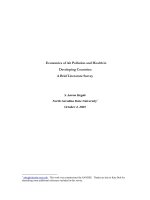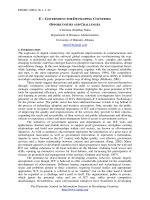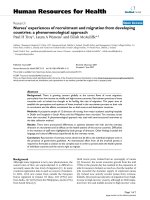Class 5 structural adjustment policies of and lending for developing countries 2018
Bạn đang xem bản rút gọn của tài liệu. Xem và tải ngay bản đầy đủ của tài liệu tại đây (428.4 KB, 11 trang )
Development Finance, MPP, VJU
Prof. Koji Fujimoto
Class 5 Structural Adjustment Policies of and Lending for Developing Countries
1973
1978
1. Structural Adjustment
(1) Definition of Structural Adjustment (SA)
SA is defined as a market-oriented economic reform process that aims at restoring a
sustainable balance of payments, reducing inflation, and creating the conditions for
sustainable growth in per capita income.
Owing to the second oil shock in 1978/79, the “Foreign Debt Problem” of nonoil producing developing countries emerged. During the early years of the crisis,
Multilateral Development Banks (MDBs) and international commercial banks
regarded this Third World Debt Problem as a liquidity problem. Soon after, however,
they realized that the problem was deep-rooted and was rather a solvency problem.
In order to solve this problem, then, the MDBs undertook several initiatives to help
reform the economic structures of the developing countries through the formulation
of Structural Adjustment Policies (SAP) and Structural Adjustment Lending (SAL).
loan(s)
(2) Structural Adjustment Policies
(ⅰ) Stabilization and Adjustment
Structural adjustment policies have two main characteristics: “stabilization (shortterm measure)” and “adjustment (long-term measure).” These characteristics are
explained by using the simple national income equation as follows.
Y = C + I + G + X – M ---------------------------------------- (1)
where C is consumption, I is investment, G is government expenditure, X is exports
and M is imports.
Replacing (C + I + G) by A; namely, A = C + I + G, we obtain an equation
Y – A = X – M ------------------------------------------------- (2)
The equation (2) above tells that, when expenditure A exceeds production Y, its
difference is equal to deficits in the balance of payments. In order to correct the
situation, then, two kinds of policies and policy measures are considered.
a. Reduction of Expenditure A: A total demand contraction policy --- through
fiscal and monetary tightening, macroeconomic imbalances are adjusted in a
short period of time. This is ‘stabilization’. Local currency devaluation is also
1
tình trạng
có thể trả
được nợ
Development Finance, MPP, VJU
Prof. Koji Fujimoto
one of the measures.
b. Increase in Production Y: Real economy strengthening policies --- various
incentive measures for producers such as reduction and abolishment of price
control, trade liberalization, lesser government intervention (privatization of
public enterprises and deregulation), and improvement of investment climate.
These policies and policy measures are meant to introduce and expand
competitive markets to utilize and allocate resources effectively and efficiently.
This is ‘adjustment’.
Table 1 Characteristics of Structural Adjustment
Stabilization
Adjustment
Macroeconomic orientation
Short-term
Microeconomic orientation
Medium- and Long-term
Demand side orientation
Supply side orientation
Finance-oriented (Monetary/ Fiscal) Real economy orientation
(3) Structural Adjustment of Major Sectors through Sectoral Reforms
The IMF and the World Bank introduced conditional lending for structural
adjustment in the early ’80s. The IMF primarily dealt with stabilization and the
World Bank with adjustment. However, as the IMF stepped into the adjustment
arena and the World Bank stepped into the stabilization arena, it is often difficult to
identify clearly which policies and policy measures belong to which institutions.
Three major (representative) sector reforms were sorted out in relation to
policy/policy-measure conditionalities and are set-in below.
(ⅰ) Public Sector Reform --- Improvement of the tax collection regime, tariff/price
increase in public utilities, re-examination of public investment programs,
devaluation of local currency, privatization of state enterprises and monopolies,
reforms of the public sector in terms of its size, role, functions and structure, and
so on.
hủy bỏ
(ⅱ) Trade Sector Reform --- abolition of ‘artificial’ quota, low and uniform tariffs,
and so on.
(ⅲ) Financial Sector Reform --- interest rate liberalization, regulatory and legal
reforms (tightening of risk exposure limits, establishment of tighter capital
adequacy ratio, strengthening of accounting standards, broadening the scope of
audits of the banks, imposition of stringent reporting requirements, improvement
2
Development Finance, MPP, VJU
Prof. Koji Fujimoto
of on-site and off-site supervision of banks by the central bank, and so on),
financial restructuring (shake-ups in the top management positions,
recapitalization of the banks where liquidity was low, cleaning-up of nonperforming assets, and so on), institutional restructuring (establishing of new
institutions, mergers and liquidation of banks and divestiture of public sector
shareholding in banks, and so on), and capital market creation (stock exchange).
(4) Sequencing and Speed of Structural Adjustment Policies
Sequencing:
When implementing structural adjustment policies, one should recognize that there
are various kinds of trade-offs between policy objectives and performances. This, in
turn, implies that policies have to be selected carefully and executed in a manner of
optimal sequencing.
(ⅰ) Devaluation of local currency results in an improvement of the trade balance.
On the other hand, however, it increases the budgetary burden of foreign currency
denominated debt services and, at the same time, causes inflation through higher
import prices in terms of local currency.
(ⅱ) Trade liberalization upgrades domestic productivity through international
competition. On the other hand, it increases imports and deteriorates the trade
balance/current account balance. In addition, lower tariff rates reduces the tariff
revenue of the government.
(ⅲ) Abolition of price controls creates internal competitive markets which determine
price levels. However, in quite a large number of developing counties it tends to
cause inflation through resulting price hikes.
(ⅳ) Financial liberalization promotes efficiency of the financial system. However, it
reduces long-term institutional lending for capital investment and increases shortterm commercial lending. Interest rate liberalization tends to increase interest
tự do hóa
rates and in turn reduce investment.
(ⅴ) Cuts in government spending often result in reductions in public works
investment projects, affecting the state of the developing country’s infrastructure.
Cuts thereby reduce growth prospects.
Speed: The Big Bang versus Gradualism
Developing countries’ experience with the process of structural adjustment has
frequently posed the question of how to time the policy changes that economic
reformers try to implement. In the early ’90s, two different approaches to this issue
of timing were widely debated. On one side of the argument were the advocates of
3
Development Finance, MPP, VJU
Prof. Koji Fujimoto
the “big bang” approach. They insisted that comprehensive stabilization and
liberalization measures should be introduced immediately at the start of the reform
process and implemented as fast as possible. They were the advocates of speed and
stealth in a top-down style reform. The classic example of this is the reforms carried
through by Lescek Balcerowicz in Poland between ‘90 and ‘92. The supporters of
the big bang in Eastern Europe and the former Soviet Union were, however,
influenced by unacknowledged political considerations. They detected a very brief
window of opportunity to demolish the economic structures that underpinned state
socialism, before disillusion with “capitalism” set in.
On the other side of the argument were the advocates of gradualism. They
pleaded for the stretching out of the reform measures over a long time period. They
reasoned that this would ease the pain of the adjustment process, allow time to
develop a political consensus in support of the reform process and thus make it more
politically sustainable. To this plea, the “big bangers” retorted that any
procrastination would add to the total costs of adjustment and would, contrary to the
rationale for gradualism, make the whole adjustment process less politically viable,
by allowing opponents of reform time to marshal their forces of political obstruction.
The World Bank and the IMF stood on the side of “Big Bangers”, while Japan
stood on the side of “Gradualismists”.
must remember
(5) Social Safety Nets
Social Safety Nets are non-contributory transfer programs targeted in some manner
to the poor or those vulnerable to poverty and shocks. Social Safety Nets play a
well-recognized redistributive role which is supported strongly by moral
philosophy, expressed in many different ways. They also play a productive role in
helping households to manage risk and assist in their own livelihoods, in helping
prevent the intergenerational transmission of poverty and in allowing societies to
make more efficient choices in macro, trade, labor and other sectoral policies.
Though less well recognized, this productive role is a very important part of the
justification for safety nets. (excerpt from the World Bank, refer also to Galbraith’s
The Good Society)
Structural adjustment policies are known to produce repercussions which call
upon the various measures found within Social Safety Nets. In the long run,
structural adjustment contributes to economic growth. However, in the short run, it
causes hardships on the poor and vulnerable, while it contributes to economic
stabilization. The following cases illustrate some impacts on the poor and
4
Development Finance, MPP, VJU
Prof. Koji Fujimoto
vulnerable.
mất giá
When the exchange rate is devalued, necessity imports become more expensive.
Cuts in government spending in sectors such as education and health may give raise
to infant mortality rates and reduce literacy more painfully on the poor and
vulnerable. Entry and near entry-level public sector employees are the first to lose
jobs when public enterprises are privatized and government spending cuts take
tư nhân hóa
place.
The issue of social safety nets associated with structural adjustment has long
been discussed from the very first economic adjustment loan extended to Bolivia
by the World Bank in 1980. Social safety nets have increasingly become an integral
part of the structural adjustment policies. Some other international development
organizations such as UNDP, ILO, WHO and UNICEF have also discussed the
issue repeatedly. In 1987, UNICEF published a report entitled “Adjustment with a
Human Face,” which dealt with the negative impacts of structural adjustment
policies/programs on health and education. Since then, the social safety net has
become an important factor, namely, a “must” in structural adjustment
policies/programs.
Today, it is said that social dimension of adjustment (SDA) is a part and parcel
of structural adjustment policies/programs.
(6) Ownership of Structural Adjustment Policies
Needless to say, the ownership of SA policies/programs rest in the hands of
developing countries. Without positive support from the general public of the
developing countries, policies/programs cannot be implemented. The SA
policies/programs need to be secured by the governments of the developing
countries. The World Bank and IMF should not and cannot sit in the driver’s seat.
2. Structural Adjustment and International Financial Assistance
(1) Needs for International Financial Assistance
Why does structural adjustment require international financial assistance? Generally
speaking, there exists a considerable time gap between formulation of policies and
accrued impacts. In order to bridge this gap, the quick-disbursement type financial
assistance from external sources is indispensable.
(ⅰ) Public Sector Reform --- It takes time to reconstruct the revenue-expenditure
system to balance the budget. During this period, developing country governments
tend to increase their budget deficits, which in turn need to be financed by donors
5
Development Finance, MPP, VJU
Prof. Koji Fujimoto
such as MDBs and bilateral aid organizations.
(ⅱ) Trade Sector Reform --- It takes fairly a long time to increase exports, while it
does not take much time to increase imports. During a trade sector reform period,
LDC governments try not to lower domestic economic activities, resulting in a
similar level of imports on par with previous years. The foreign exchange gap may
thereby increase, which in turn needs to be financed by donors such as MDBs and
bilateral aid organizations.
(ⅲ) Financial Sector Reform --- In order to strengthen the banking sector, huge funds
are generally needed. LDC governments must supply needed funds by making the
most use of external sources such as MDBs and bilateral donor organizations.
Government revenue shortage caused by restructuring of the banking sector often
need to be replenished by funds borrowed from MDBs and bilateral aid
organizations.
(2) World Bank’s Structural Adjustment Loan (SAL) and IMF’s Extended Credit Facility
(ECF)
The World Bank started its SAL operation in 1980 and newly introduced the SECAL
operation (Sector Adjustment Lending) in 1983. The former covers the entire
economy and the latter deals with specific sectors such as public, trade, and finance.
SAL and SECAL are referred to as non-project lending/loan (or program
lending/loan).
In collaboration with the World Bank, IMF introduced SAF (Structural
Adjustment Facility) in 1986, and SAF was enforced into ESAF (Enhanced
Structural Adjustment Facility) in 1987. In 1999 ESAF was replaced by Poverty
Reduction and Growth Facility (PRGF) as the World Bank employed a new lending
policy based on the “Poverty Reduction Strategy Paper.” In January 2010, PRGF
was replaced by Extended Credit Facility (ECF).
One of IMF’s concessional lending arrangements to low-income countries is
ECF (former PRGF) which is underpinned by comprehensive country-owned
strategies, delineated in their Poverty Reduction Strategy Papers (PRSPs). In recent
years, the largest number of IMF loans had been made through the PRGF. The
interest rate levied on PRGF was only 0.5%, and loans were to be repaid over a
period of 5 ½ – 10 years, while in the case of present ECF, 0% interest rate and 10
(5½) years repayment period.
Similarly to the World Bank and IMF, regional MDBs such as AsDB, IDB and
AfDB have been providing low-income countries structural adjustment loans.
6
Development Finance, MPP, VJU
Prof. Koji Fujimoto
Bilateral aid organizations used to co-finance with MDBs.
(3) Cooperation between IMF and the World Bank
Prior to the ‘70s, the IMF policy prescription for a balance of payments deficit was
a temporary infusion of foreign capital to meet currency shortfalls or currency
devaluation where deficits had become chronic. The Bretton Woods conference
assigned the task of supervising foreign exchange flows exclusively to IMF,
accordingly there was little overlap between IMF and World Bank activities. Thus
IMF remained responsible for balancing external accounts through macroeconomic
adjustments, while the World Bank influenced domestic production through the
microeconomic policy. Events during the past three decades, however, have
reduced the mutual exclusivity of these roles. Oil price shocks, falling exports,
declining terms of trade, and capital flight experienced by developing countries
made it clear that Third World trade imbalances had become structural in nature.
To improve the status of developing countries vis-à-vis the developed countries’
trading partners, IMF deemed it necessary that Third World countries adopt
stabilization policies to lower inflation, improve the efficiency of internal markets
and institutions, lower domestic government spending, and review public
investments, in addition to reforming their exchange-rate regimes. By becoming
involved in these related negotiations, IMF extended its activities into areas that
had traditionally been within the sphere of influence of the World Bank. Similarly,
the Bank came to recognize that promoting domestic GNP growth would require
consideration of external factors. Consequently, the World Bank’s structural
adjustment programs began to include provisions for enhancing the international
competitiveness of domestic products through the reform of trade policies and
exchange-rate regimes. Thus in an analogous manner, the World Bank has intruded
into the domain of the IMF.
Since maintaining equilibrium on external accounts is not conducive to longterm economic growth, IMF and World Bank policies have not always been
consistent with each other. The remarkable similarity between the IMF
conditionality and World Bank structural adjustment policy is the result of a
convergence in approaches that occurred during the ‘70s and ‘80s. There is a
growing recognition that the successful resolution of both external and internal
problems requires the simultaneous coordination of macroeconomic and
microeconomic policies. This has led to greater cooperation between the World
Bank and IMF and a blurring of the distinctions in their respective roles. (See
7
Development Finance, MPP, VJU
Prof. Koji Fujimoto
Todaro’s Economic Development, Seventh Edition, p.574)
More specifically, the World Bank when preparing a PFP (Policy Framework
Paper) for a member of developing country establishes a tri-party working team
(IMF / World Bank / Developing Country) to formulate the paper in a coordinated
manner. In preparing a PRSP (Poverty Reduction Strategy Paper), too, IMF and the
World Bank staff work together to support the LDC government. Incidentally, a
PRSP is obligatorily formulated only for IDA countries and HIPCs in place of a
PFP.
3. Conditionality
(1) IMF and World Bank Conditionality
Conditionality is defined as economic policies or structural reforms that developing
member countries agree to follow as a condition for the use of IMF and World Bank
resources (loans) and are often referred to as performance criteria or benchmarks. A
borrowing country of any IMF facility is requested to pursue macroeconomic
(macro-fundamentals such as inflation, budget deficits and foreign payments
deficits) stabilization policies spelled out in the IMF Stabilization Program which
consist of “Letter of Intent”, “Memorandum of Economic and Financial Policies”
and “Technical Memorandum of Understanding”. As a matter of fact, IMF
conditionalities are spelled out in Memorandum of Economic and Financial Policies.
There are four basic components of conditionalities to the typical IMF
stabilization program.
(ⅰ) Abolition or liberalization of foreign exchange and import controls.
(ⅱ) Devaluation of the official exchange rate.
(ⅲ) A stringent domestic anti-inflation program consisting of (a) control of bank
credit to raise interest rates and reserve requirements; (b) control of the
government deficit through curbs on spending, especially in the areas of social
services for the poor and staple food subsidies, along with increases in taxes
and public enterprise prices; (c) control of wage increases, in particular
ensuring that such increases are at rates less than the inflation rate (i.e.,
abolishing wage indexing); and (d) dismantling of various forms of price
controls and promoting freer markets.
(ⅳ) Greater hospitality to foreign investment and a general opening up of the
economy to international commerce.
An IMF loan is disbursed in a few tranches against a periodical (3 to 6 months)
review of indicative targets and quantitative performance criteria as well as
8
Development Finance, MPP, VJU
Prof. Koji Fujimoto
structural performance criteria and benchmarks. (Specific targets and criteria
are obtainable from the IMF Letter of Intent and related documents)
On the other hand, the World Bank’s structural adjustment lending is a
quick-disbursement and policy-based lending. The Bank’s adjustment loan is
normally disbursed in two to three times. The first disbursement is made when
a borrowing country formulates basic plans/programs for short-term
stabilization and long-term structural reform. The second and the third are made
when further decisive policy measures to carry out the plans/programs are
determined according to schedule. Thus, the World Bank conditionality consists
of these conditions for disbursements.
(2) Critical View on Conditionality
It has been argued from various angles that IMF/World Bank conditionality did not
lead to the expected outcome. This issue can be reviewed from the theoretical as well
as the operational aspect.
(ⅰ) Excessive bias on market mechanism
Structural adjustment policies are based on market-oriented neo-classical
economics and, therefore, the following scenario forms a base for structural
adjustment policies.
Market-oriented economy functions if excessive government intervention is
eliminated.
Private sector economic activities are then activated as the environment for
private sector businesses is improved.
As a result, investment and production increase. Exports, in turn, also
increase owing to improved international competitiveness.
Owing to the virtuous circle of investment, production and exports, the
economy starts its sustainable growth.
It is questionable if this scenario works fully or not. However, if it does, for
9
Development Finance, MPP, VJU
Prof. Koji Fujimoto
example, the scenario leads to the conclusion that an industrial policy for infant
industry development (or “an infant industry development policy”) should never
be introduced in developing countries.
In relation to the argument above, the ineffective and unrealistic World Bank
conditionality is often observed. Some cases are presented below.
Case 1. Trade liberalization induced massive inflow of cheap textile goods from
India and Pakistan, which almost destroyed the textile industry, one of a
few industries, of Kenya and Tanzania.
Case 2. Privatization of state-owned monopolistic marketing boards in African
countries resulted in promoting private sector wholesale monopolies.
Case 3. Privatization of a parastatal cotton corporation in Togo caused a reduction
in extension and technical services, resulting in the reduction of cotton
production.
Case 4. Privatization of the parastatal bus company in Sri Lanka upgraded service
quality but at the same time increased bus fare. As a result, a large number
of poor people in rural areas lost access to bus services.
There are still many developing countries where the markets themselves and
the market mechanism are not well-established. In such countries, the neo-classical
economic scenario described above is far from their reality. In such cases, the
government, therefore, has to play a much more important role in promoting
economic growth.
(ⅱ) Operational issues
a. Uniformity of conditionality and lack of global consideration
IMF’s uniform prescription of stabilization program has long been argued. Caseby-case and country-by-country prescription is definitely required.
One case of inadequate coordination of World Bank conditionalities has been
witnessed in the production cacao in developing countries. A World Bank mission
to Ghana recommended the government of Ghana to increase cacao exports
through devaluation. Other missions promoted the same recommendation to other
cacao producing countries such as Brazil, the Ivory Coast and Ecuador. As a result,
the cacao price dropped considerably worldwide. All those countries lost
substantial economic income and foreign exchange earnings mainly due to the
World Bank recommendation.
b. Abrupt and disorderly prescription
The Big Bang approach of IMF and the World Bank produces mixed results. This
approach works for macroeconomic and financial reforms for short-tern
10
Development Finance, MPP, VJU
Prof. Koji Fujimoto
stabilization. But real economic structures often represented in terms of
production and employment cannot be restructured in the short run. Such
structures not only require long term activity but also require to follow an optimal
sequence which is often extremely difficult. The Big Bang approach was applied
to the case of the Russian economic reform. More specifically, Russia abruptly
privatized state-owned enterprises before fulfilling pre-conditions needed for
privatization. As a result, Russia had to suffer prolonged economic downsizing.
On reflection, the Gradualism approach is argued as an alternative approach.
Gradualismists insist that Gradualism is superior to the Big Bang as the former
can utilize time wisely to adjust the structural reforms to the pre-conditions and
changing conditions of the transitional economies all within their administrative
capacities. In other words, risks involved in the gradualism approach are much
lower than those of the big bang approach.
(ⅲ) Ownership issue
Developing countries are in a position of “cannot help accepting IMF/World Bank
conditionality.” However, painful economic reforms cannot be successfully
implemented unless people of developing country recognize their importance and
support the objectives positively. IMF/World Bank definitely needs to respect the
ownership of the developing countries and explore jointly ways and means to
integrate views and opinions of other development stakeholders such as the
private businesses and civil society organizations.
✍
11









